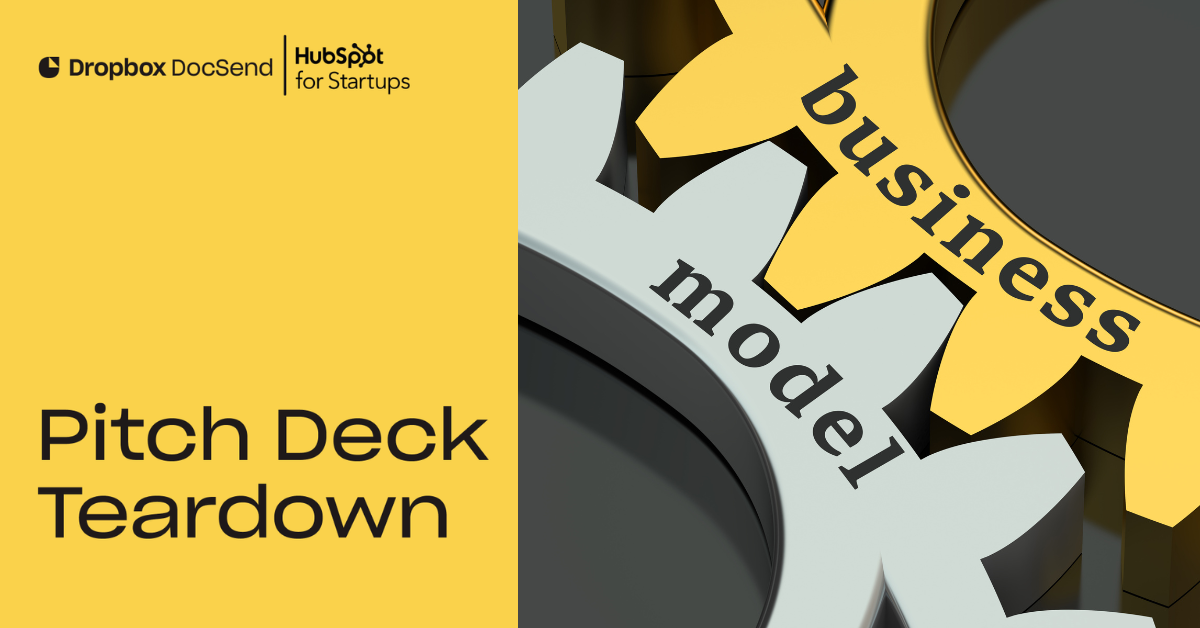Pitch Deck Teardown Recap: The Business Model
Four investment professionals breakdown the business model slides from four different startup founder pitch decks.
written by: Kim Wacker
edited by: Ron Dawson

Four investment professionals breakdown the business model slides from four different startup founder pitch decks.
written by: Kim Wacker
edited by: Ron Dawson

HubSpot for Startups and secure file sharing platform, Dropbox DocSend, recently joined several investment professionals and a pitch deck consultant for a live teardown of four startup founders’ pitch decks. This is the process of providing information about a pitch deck, such as how to allocate priorities, what metrics to highlight, design recommendations, etc. As a founder, this process is invaluable because the recommendations can make the difference between getting that 7-figure investment or hearing, “Thanks, but no thanks.”
During the teardown, the panel of experts examined four sections of each pitch deck: business model, traction, market size, and competition. The panelists shared their expertise and valuable insights on how founders can improve their pitch deck and take it to the next level. The first section the panelists weighed in on during the teardown was the business model.
The business model slide is a critical component of a pitch deck because it is how you will convince investors that your business model will work and will generate a profitable return on investment (ROI). Think of it as a snapshot of your company’s essence.
The slide should feature a clear visual representation of your company’s revenue streams and its value in the market—blending both compelling storytelling and data. Flowcharts and pricing charts are often used to define how the company will generate revenue in simple terms.
During a pitch deck teardown, investment professionals will examine the business model section closely to understand the company's viability and scalability. They will typically analyze revenue streams, customer segments, value proposition, cost structure, distribution channels, key resources and partnerships, and overall growth potential.
The panelists reviewed four sections of the pitch decks from four different companies: Alps AI, Map Hunter, Ulama, and Soap Health. They started with an analysis of the business model slides in each deck, and then each provided a summary of their expert advice.
Alps AI is an AI-powered platform for IT hiring and talent acquisition.
It was noted that the picture in the middle of the slide was just decoration, and not needed, as it wasn’t crucial to the overall communication. Images can be distracting, especially if they are too busy and take away from the messaging.

The panelists suggested that the slide be cleaned up because it was too visually complex, and needed to be stripped down to its essence. They recommended that the founder instead discuss the core basics of the business model first, and then later expand on the details.
Additionally, it was mentioned that many founders who aren't located in the US are talking to US audiences. This makes it unclear as to whether they’re planning on raising funds from US VCs or not. Differentiating those numbers with periods and commas would help with clarification. In reviewing this slide, there was a unanimous question across the board as to how the company planned to achieve its financial goals.
Map Hunter is a travel app that allows tourists to access customizable content from anywhere.
The feedback on this slide was that it was too complex. It was difficult to follow the track and to understand how the company was going to go to market. The experts also said that the business model was a little convoluted, and going after so many customers simultaneously would be challenging.

The recommendation was to focus on one segment at a time, such as self-serve B2B, otherwise, the VCs will think that the company is trying to accomplish too much at once. Additionally, it was advised to eliminate the mention of owned data, because that information will only be valuable once the company has gained more success down the line.
It was also suggested to nix the subheadings under “customer products,” as they were confusing. The experts said it was a red flag to show both a B2B and a B2C go-to-market approach because it makes it seem like the company doesn’t know who its customers are. The advice was to hone in on one customer or one segment first.
Ulama is a platform that automates the approval of construction projects and permit applications.
The team pointed out that the Ulama slide was clean and simple, with visuals that weren’t too distracting. It was clear that the company was talking about businesses.

Additionally, the feedback was that talking about government agencies can be complicated, but they did a great job breaking this down on the slide. The team also liked that pricing was eliminated from this section, as they didn’t feel it was needed.
The panelists noted that the company clearly highlighted its three tiers — essentials, pro, and enterprise — as investors will expect that. Overall, this slide had the least amount of words, and according to the experts, made it the most successful.
It was reiterated that less is more, and this slide was unanimously voted the favorite among the panelists.
Soap Health is an AI-powered primary care provider.
The experts felt that the go-to-market and the business model should be separate slides. The business model slide should clearly state how the company plans to make money, including the pricing. The go-to-market slide should be more concise and less wordy, as too much text makes it difficult to hone in on key market activity. It was advised to share a more narrow focus of where you plan to concentrate your efforts and how you will convert your target customers.

The panelists agreed that this slide was difficult to follow, making it hard to determine what the company wanted to achieve. It wasn’t clear as to how each go-to-market item was going to monetize the business. It was also suggested to present a circular image of the four go-to-market items instead of side by side since they all work together.
The overarching message gained from the panelists’ feedback was that there needed to be a greater focus on the formatting of the pitch decks. Since most investors only spend a few minutes per slide, there should be just headlines, not headers—making it easy to understand who the company is and what they are doing.

The goal of a pitch deck is to first peak someone’s interest so they will want to learn more and set up a meeting. Investors don’t need to know every single detail about the business model before having a conversation. There will be plenty of time to dig deeper during future meetings.
Your pitch deck should also include clear details on how you plan to make money, what the percentage cuts are (if applicable), and the projected transaction volume.
When crafting an initial pitch deck, and particularly, the business model, the advice from the experts is crystal clear — keep it simple!
Follow us to the next post in the series where we’ll summarize the expert’s feedback on traction.
 Matt Gore
Matt GoreMatt has helped founders raise more than $2B from firms like a16z by crafting world-class pitch decks. He founded OPTIO, a strategic storytelling agency, after working at the Boston Consulting Group and the Saturn Five Venture. His mission is to serve busy founders and investors who need to raise $2M to $500M.
OPTIO specializes in making pitch decks to help founders raise money and build the venture of their dreams. The company provides a three-step approach to deck creation: strategy, design, and story. To date, OPTIO pitch decks have helped founders raise as much as $100 million in a single round.
 Olivia O'Sullivan
Olivia O'SullivanOlivia is a Partner at Forum Ventures, a leading early-stage fund, program, and community for B2B SaaS startups. She focuses on sourcing and evaluating investment opportunities and post-investment portfolio support.
Founded in 2014 as Acceleprise, Forum is on a mission to make the B2B SaaS journey easier, more accessible, and more successful for early-stage founders through pre-seed and seed-stage funding, high-touch programming, corporate perks and introductions, and an active SaaS community.
Olivia enjoys building communities, connections, and resources that help early-stage founders go from zero to sustainable. In addition to Forum, she is an active angel investor, mentor, and ultra-marathoner. Olivia joined Forum Ventures from Dow Jones where she managed Product & Innovation Strategy.
 Dustin Betz
Dustin BetzDustin is the Director of Operations at White Rose Ventures, a firm that invests in early-stage Pennsylvania-based startups across industry sectors. A former eCommerce D2C brand founder, Dustin also spent five years at Founder Institute HQ, the world's largest pre-seed startup accelerator, where he helped to lead their Funding Lab post-program for actively fundraising portfolio companies.
White Rose Ventures is a network-driven venture firm that works with entrepreneurs, foundations, private investors, and corporate partners to deliver solutions that enhance and promote a regional business ecosystem.
 Karim Anchassi
Karim AnchassiKarim is a seasoned professional with over nine years of experience in M&A and venture capital. He currently works in Corporate Development and Ventures for the leading cloud storage solution, Dropbox. The popular file hosting service offers cloud, storage, streamlined file synchronization, sharing, collaboration, personal cloud, and client software—enabling users to securely store files online and access them anywhere with an internet connection.
Karim graduated from Georgetown University with a degree in finance and information systems. Afterward, he pursued a career in investment banking, focusing on the tech industry. He worked at Cisco in Corporate Development, where he was involved in both M&A and venture capital activities in the Big Data space.
Later, he joined Dropbox's Corporate Development team, where he executed several acquisitions and has been actively investing in AI-first companies as part of Dropbox Ventures.
The value of DocSend’s platform is that it allows you to take ownership of your fundraising process with the help of secure document sharing and real-time analytics. This enables founders to easily share their pitch decks with potential investors while gaining insight into how and where they are spending time in the deck.
HubSpot for Startups has partnered with Vestbee to help connect the global VCs in our network, with startup founders and entrepreneurs looking for advice on growth, and access to more funding.
Managing your raise can be a challenge, but we're here to help! Complete these steps to add powerful, free fundraising tools to your instance of HubSpot in minutes!

Arjun Mahadevan, CEO & co-founder of doola, shares how their pitch deck helped them get a $1M investment from HubSpot Ventures.

Startup pitch decks are the key to securing funds for growing your business. Study these successful pitch decks and use our template to help your startup grow.

This article will explore the “How We Get Big” slide, a crucial part of any pitch deck.
